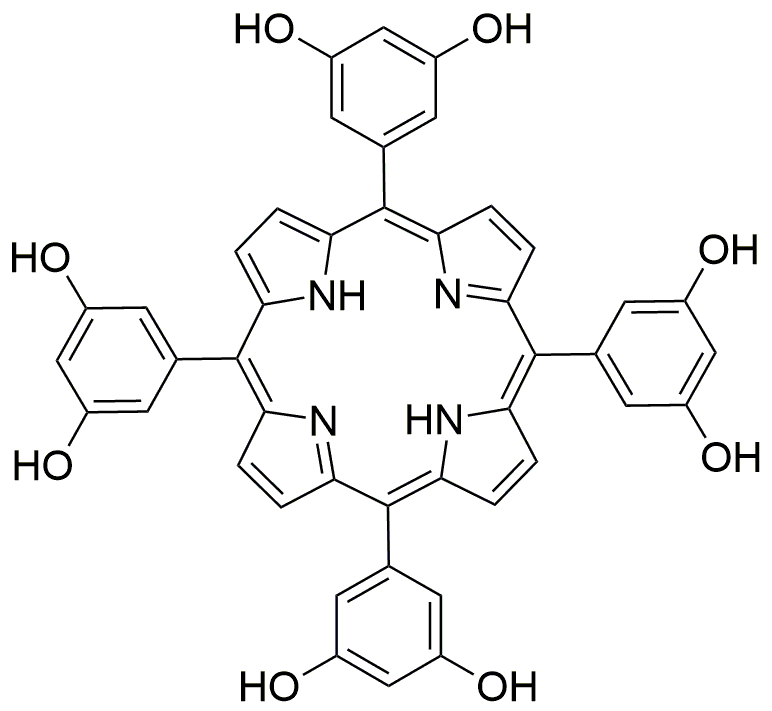5,10,15,20-Tetrakis(3,5-dihydroxyphenyl)porphyrin is widely utilized in research focused on:
- Photodynamic Therapy (PDT): This compound is effective in PDT, a treatment for certain cancers, where it helps to generate reactive oxygen species upon light activation, targeting and destroying cancer cells.
- Solar Energy Conversion: Its unique structure allows for efficient light absorption, making it a candidate for use in solar cells, enhancing energy conversion efficiency.
- Biomedical Imaging: The compound can be used as a contrast agent in imaging techniques, improving the visibility of tissues and aiding in the diagnosis of diseases.
- Antioxidant Applications: Its antioxidant properties make it useful in formulations aimed at reducing oxidative stress, which is beneficial in skincare and cosmetic products.
- Environmental Remediation: The compound can be applied in processes to remove pollutants from water, showcasing its potential in environmental science and sustainability efforts.
General Information
Properties
Safety and Regulations
Applications
5,10,15,20-Tetrakis(3,5-dihydroxyphenyl)porphyrin is widely utilized in research focused on:
- Photodynamic Therapy (PDT): This compound is effective in PDT, a treatment for certain cancers, where it helps to generate reactive oxygen species upon light activation, targeting and destroying cancer cells.
- Solar Energy Conversion: Its unique structure allows for efficient light absorption, making it a candidate for use in solar cells, enhancing energy conversion efficiency.
- Biomedical Imaging: The compound can be used as a contrast agent in imaging techniques, improving the visibility of tissues and aiding in the diagnosis of diseases.
- Antioxidant Applications: Its antioxidant properties make it useful in formulations aimed at reducing oxidative stress, which is beneficial in skincare and cosmetic products.
- Environmental Remediation: The compound can be applied in processes to remove pollutants from water, showcasing its potential in environmental science and sustainability efforts.
Documents
Safety Data Sheets (SDS)
The SDS provides comprehensive safety information on handling, storage, and disposal of the product.
Product Specification (PS)
The PS provides a comprehensive breakdown of the product’s properties, including chemical composition, physical state, purity, and storage requirements. It also details acceptable quality ranges and the product's intended applications.
Certificates of Analysis (COA)
Search for Certificates of Analysis (COA) by entering the products Lot Number. Lot and Batch Numbers can be found on a product’s label following the words ‘Lot’ or ‘Batch’.
Numéro de catalogue
Numéro de lot/série
Certificates Of Origin (COO)
This COO confirms the country where the product was manufactured, and also details the materials and components used in it and whether it is derived from natural, synthetic, or other specific sources. This certificate may be required for customs, trade, and regulatory compliance.
Numéro de catalogue
Numéro de lot/série
Safety Data Sheets (SDS)
The SDS provides comprehensive safety information on handling, storage, and disposal of the product.
DownloadProduct Specification (PS)
The PS provides a comprehensive breakdown of the product’s properties, including chemical composition, physical state, purity, and storage requirements. It also details acceptable quality ranges and the product's intended applications.
DownloadCertificates of Analysis (COA)
Search for Certificates of Analysis (COA) by entering the products Lot Number. Lot and Batch Numbers can be found on a product’s label following the words ‘Lot’ or ‘Batch’.
Numéro de catalogue
Numéro de lot/série
Certificates Of Origin (COO)
This COO confirms the country where the product was manufactured, and also details the materials and components used in it and whether it is derived from natural, synthetic, or other specific sources. This certificate may be required for customs, trade, and regulatory compliance.


